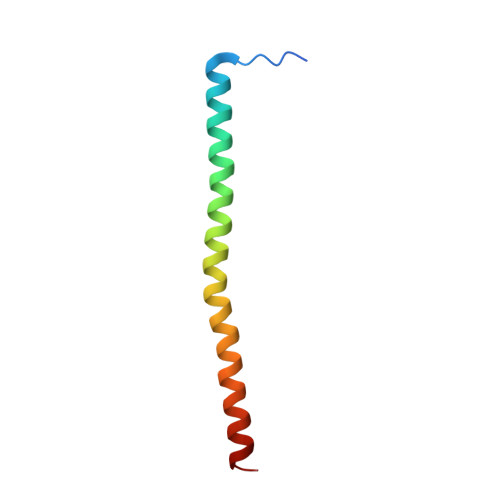A stable transcription factor complex nucleated by oligomeric AML1-ETO controls leukaemogenesis.
Sun, X.J., Wang, Z., Wang, L., Jiang, Y., Kost, N., Soong, T.D., Chen, W.Y., Tang, Z., Nakadai, T., Elemento, O., Fischle, W., Melnick, A., Patel, D.J., Nimer, S.D., Roeder, R.G.(2013) Nature 500: 93-97
- PubMed: 23812588
- DOI: https://doi.org/10.1038/nature12287
- Primary Citation of Related Structures:
4JOL - PubMed Abstract:
Transcription factors are frequently altered in leukaemia through chromosomal translocation, mutation or aberrant expression. AML1-ETO, a fusion protein generated by the t(8;21) translocation in acute myeloid leukaemia, is a transcription factor implicated in both gene repression and activation. AML1-ETO oligomerization, mediated by the NHR2 domain, is critical for leukaemogenesis, making it important to identify co-regulatory factors that 'read' the NHR2 oligomerization and contribute to leukaemogenesis. Here we show that, in human leukaemic cells, AML1-ETO resides in and functions through a stable AML1-ETO-containing transcription factor complex (AETFC) that contains several haematopoietic transcription (co)factors. These AETFC components stabilize the complex through multivalent interactions, provide multiple DNA-binding domains for diverse target genes, co-localize genome wide, cooperatively regulate gene expression, and contribute to leukaemogenesis. Within the AETFC complex, AML1-ETO oligomerization is required for a specific interaction between the oligomerized NHR2 domain and a novel NHR2-binding (N2B) motif in E proteins. Crystallographic analysis of the NHR2-N2B complex reveals a unique interaction pattern in which an N2B peptide makes direct contact with side chains of two NHR2 domains as a dimer, providing a novel model of how dimeric/oligomeric transcription factors create a new protein-binding interface through dimerization/oligomerization. Intriguingly, disruption of this interaction by point mutations abrogates AML1-ETO-induced haematopoietic stem/progenitor cell self-renewal and leukaemogenesis. These results reveal new mechanisms of action of AML1-ETO, and provide a potential therapeutic target in t(8;21)-positive acute myeloid leukaemia.
- Laboratory of Biochemistry and Molecular Biology, The Rockefeller University, New York, New York 10065, USA.
Organizational Affiliation:

















